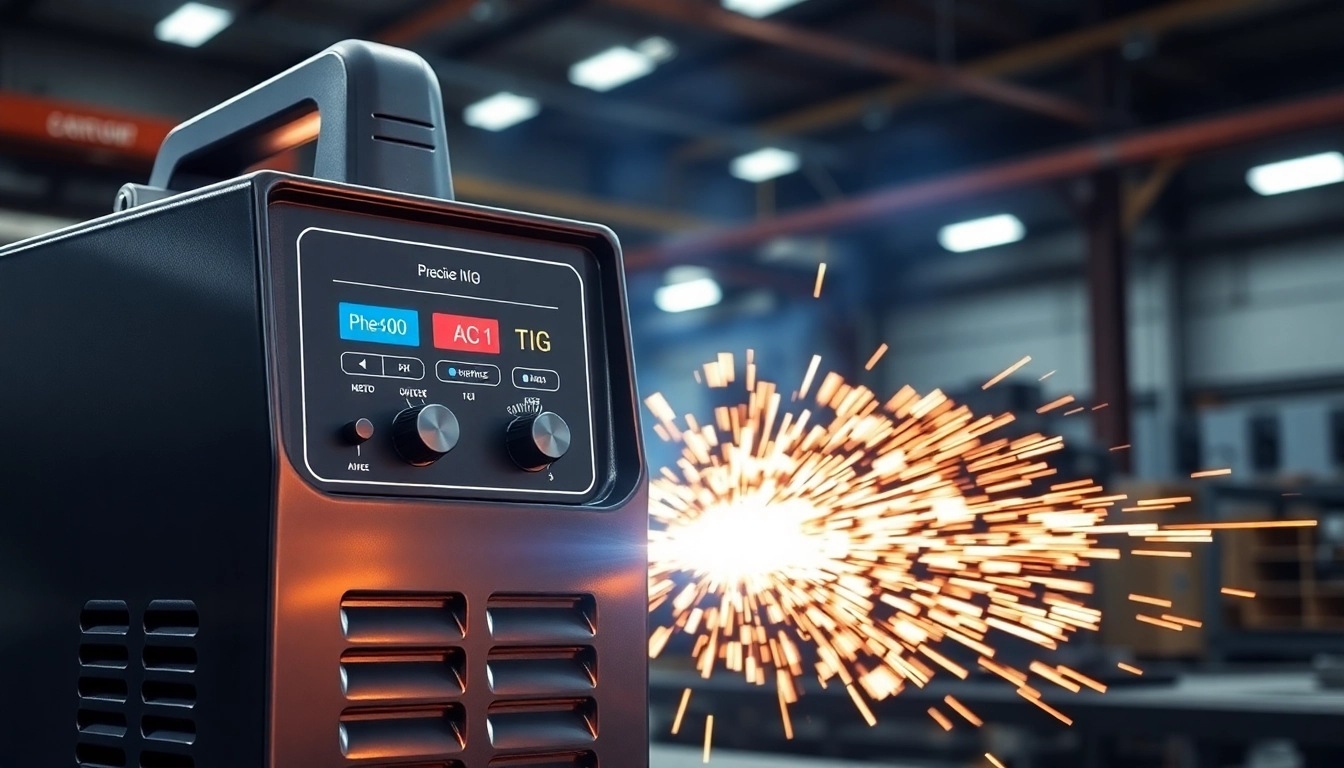Understanding AC DC TIG Welders
What is an AC DC TIG Welder?
TIG welding, also known as Tungsten Inert Gas welding, is a welding process that uses a non-consumable tungsten electrode to produce the weld. An ac dc tig welder operates on both alternating current (AC) and direct current (DC), allowing for versatility in welding various types of metals. AC is especially beneficial for tasks involving aluminum and magnesium, as it provides a cleaning action that removes oxides from the surface and promotes a strong weld. On the other hand, DC is typically used for welding steel and other alloys where a stable melt pool is crucial.
Key Benefits of Using an AC DC TIG Welder
One of the primary advantages of an AC DC TIG welder is its versatility. The ability to switch between AC and DC modes equips welders to tackle a wider range of materials and applications, from welding thin sheets of aluminum to precision steel fabrication. Other notable benefits include:
- Precision and Control: TIG welding provides superior control over the heat input and the weld pool, making it ideal for critical applications.
- Clean Welds: The process produces minimal spatter, resulting in cleaner and aesthetically pleasing welds.
- Strong Welds: The high-quality welds produced with TIG welding have excellent mechanical properties.
- Minimal Post-Weld Cleanup: Due to the cleanliness of the welds, less post-weld treatment is usually needed.
- Flexibility: Being able to use both AC and DC expands welding possibilities significantly.
How AC and DC Settings Impact Welding
The choice between AC and DC settings can significantly impact the welding performance. AC is advantageous for aluminum welding because it provides a cleaning cycle that erodes any oxide layer, leading to a cleaner substrate for welding. Conversely, DC is preferred for welding ferrous metals, providing a stable arc with better penetration and a smoother finish. Using AC helps maintain a consistent arc length and can reduce the risk of defects in the weld.
Choosing the Right AC DC TIG Welder
Factors to Consider When Selecting a Welder
When selecting the right AC DC TIG welder, several factors play a crucial role in determining the equipment that best suits your needs:
- Power Output: Consider the amperage required for your projects. Most home applications can be served well by welders with 150 to 250 amps.
- Duty Cycle: This reflects the welder’s operational time before it needs to cool down. A higher duty cycle is essential for extended welding sessions.
- Portability: If you need to move the welder frequently, consider its weight and ease of transport.
- Foot Pedal Operation: This allows for better control of the welder while freeing up your hands for work.
- Type of TIG Torch: Some welders come with high-quality torches, while others may require additional purchases.
Top Brands in AC DC TIG Welding
When it comes to AC DC TIG welders, some brands stand out for their quality and reliability:
- Miller Electric: Renowned for durable and high-performance machines, Miller offers a variety of TIG machines suitable for both professionals and hobbyists.
- Linde: Known for their robust, industrial-grade welders, Linde provides equipment for heavy-duty welding tasks.
- Lincoln Electric: This brand offers innovative technology and features in its TIG welders, aiming to enhance user outcomes.
- Everlast: They provide affordable options without sacrificing quality, which makes them a popular choice among DIY enthusiasts.
- PrimeWeld: They specialize in value-driven TIG welders that cater to both entry-level and advanced users.
Price Ranges and Budget Options
The price range for AC DC TIG welders varies significantly based on brand, features, and power capacity. A basic model might cost around $200, while mid-range welders can range from $600 to $1,500. Premium models featuring more advanced technology and increased amperage can reach upwards of $3,000 to $5,000. For individuals on a budget, brands like Everlast and PrimeWeld offer quality welders at competitive prices that do not compromise on performance.
AC DC TIG Welding Techniques
Basic Techniques for Beginners
Beginning welders should focus on mastering fundamental skills, which include:
- Setting Up: Always set up your equipment correctly, taking care to connect your argon gas supply and adjust your welder settings according to the material thickness.
- Maintaining Arc Length: A consistent arc length of about 1/8 inch helps avoid defects and maintains weld quality.
- Feeding the Filler Rod: Introduce the filler rod into the weld pool gradually and keep it perpendicular to the materials being welded.
- Controlling Speed: Practice moving steadily and at a consistent speed to create uniform beads.
Advanced Techniques for Experienced Welders
For seasoned welders, enhancing skill sets with advanced techniques is essential for taking on more complex projects:
- Pulsed TIG Welding: This technique adds a variable amperage, allowing for higher precision in heat management and reducing warping.
- TIG Welding with Backing Bars: Using backing bars prevents warping and enhances penetration in thicker materials.
- Manipulating the Torch Angle: Changing the angle of the torch can create different bead shapes and improve control over the weld pool.
- Heat Control Techniques: Utilizing preheating and post-weld heat control helps manage the residual stress and enhance weld quality.
Common Mistakes to Avoid
Whether a novice or experienced welder, it’s vital to recognize and avoid common mistakes:
- Improper Gas Flow: Inadequate or excessive gas flow can result in contamination of the weld.
- Incorrect Amperage Settings: Misadjusted amperage can lead to poor penetration or overheating.
- Inconsistent Travel Speed: Altering your speed can create inconsistent weld beads and weak spots.
- Neglecting Safety: Always use safety gear, including gloves and a helmet, to protect yourself from harmful fumes and UV radiation.
Applications of AC DC TIG Welders
Best Materials for AC DC TIG Welding
AC DC TIG welders are versatile tools, accommodating a range of materials including:
- Aluminum: Thanks to the cleaning effect of AC, aluminum is one of the most common materials welded using this method.
- Stainless Steel: The precision of TIG welding makes it perfect for joining various grades of stainless steel.
- Carbon Steel: Provides a strong and durable weld, ideal for structural applications.
- Copper and Alloys: TIG welding allows for quality joint formation in copper, commonly in electrical applications.
- Titanium: A strong but lightweight metal often used in aerospace applications, titanium welding benefits from the high heat control of TIG.
Industries That Utilize AC DC TIG Welders
The precision and quality achieving by AC DC TIG welding make it widely used across various industries:
- Aerospace: The aerospace industry employs TIG welding for high-quality welds in aircraft components, ensuring safety and durability.
- Automotive: Many automotive manufacturers use TIG welding for the fabrication of components, particularly in high-performance vehicles.
- Manufacturing: Used for constructing parts that require precision and durability, especially in pressure vessels and pipelines.
- Art and Sculpture: Artists often use TIG welding to create metal sculptures due to the aesthetic finish it provides.
Real-World Projects and Case Studies
Understanding practical applications can provide insights into the capabilities of AC DC TIG welders. For instance:
- Automotive Restoration: A vintage car restoration project required welding aluminum components. An AC DC TIG welder provided the necessary precision and control to preserve the integrity of the original parts.
- Industrial Machinery Fabrication: A company specializing in manufacturing custom equipment used AC DC TIG welding for creating pressure vessels, noting the enhanced structural integrity compared to MIG welding.
- Aerospace Components: Another example comes from the aerospace sector, where a manufacturer faced challenges with traditional welding techniques. By shifting to AC DC TIG welding, they achieved stronger joints and reduced the weight of critical components, improving overall efficiency.
Maintaining Your AC DC TIG Welder
Regular Maintenance Tips
To prolong the life of your AC DC TIG welder, follow these maintenance practices:
- Keep it Clean: Regularly inspect and clean your welder to prevent dust and debris buildup.
- Check Connections: Ensure all cables and connections are secure to avoid operational failures.
- Inspect Consumables: Regularly check tungsten electrodes and gas nozzles for wear and replace them as needed.
- Monitor Gas Flow: Ensure that the gas flow rate is consistent and adjust as necessary for optimal performance.
Troubleshooting Common Issues
Even with regular maintenance, issues may arise. Some common problems include:
- Inconsistent Arc: This could be caused by poor settings or contaminated tungsten. Re-examine your settings and replace the tungsten if needed.
- Poor Penetration: Often a result of insufficient power settings or incorrect filler rod presentation. Adjust the welder settings and practice your technique.
- Excessive Spatter: A clear sign that the gas coverage may be insufficient or the arc length is too long. Both can be adjusted to improve weld quality.
When to Seek Professional Help
If your welder experiences persistent issues that troubleshooting cannot resolve, it may be time to consult a professional. Similarly, if you plan to undertake significant repairs or upgrades to your equipment, expert assistance can ensure both safety and optimal performance.



